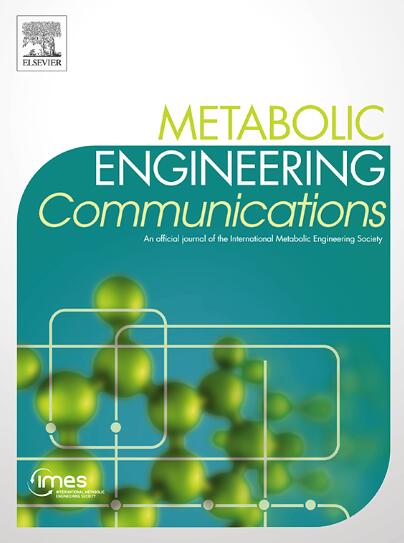Improvement of D-lactic acid production from methanol by metabolically engineered Komagataella phaffii via ultra-violet mutagenesis
IF 4.1
Q2 BIOTECHNOLOGY & APPLIED MICROBIOLOGY
引用次数: 0
Abstract
Methanol has attracted attention as an alternative carbon source to petroleum. Komagataella phaffii, a methanol-assimilating yeast, is a useful host for the chemical production from methanol. A previous study successfully constructed a metabolically engineered K. phaffii GS115/S8/Z3 strain capable of producing D-lactic acid from methanol. In this study, we aimed to develop a strain with improved D-lactic acid production by applying ultra-violet mutagenesis to the D-lactic acid-producing strain, GS115/S8/Z3. The resulting mutant strain DLac_Mut2_221 produced 5.38 g/L of D-lactic acid from methanol, a 1.52-fold increase compared to the parent strain GS115/S8/Z3. The transcriptome analysis of the mutant DLac_Mut2_221 identified 158 differentially expressed genes, providing insights into key mechanisms contributing to enhanced D-lactic acid production. Metabolic engineering strategies for K. phaffii based on the knowledge gained from this study will contribute to improving the productivity of various useful chemicals from methanol.
紫外诱变诱导代谢工程法菲Komagataella phaffii甲醇产d -乳酸的研究
甲醇作为一种可替代石油的碳源已引起人们的关注。法菲Komagataella phaffii是一种甲醇同化酵母,是甲醇化工生产的有益宿主。先前的研究成功构建了代谢工程的K. phaffii GS115/S8/Z3菌株,能够从甲醇中产生d -乳酸。本研究通过对产d乳酸菌株GS115/S8/Z3进行紫外诱变,获得一株产d乳酸能力较强的菌株。突变菌株DLac_Mut2_221从甲醇中产生5.38 g/L的d -乳酸,比亲本菌株GS115/S8/Z3增加了1.52倍。突变体DLac_Mut2_221的转录组分析鉴定了158个差异表达基因,为促进d -乳酸生成的关键机制提供了见解。基于本研究获得的知识的法菲氏菌代谢工程策略将有助于提高甲醇中各种有用化学物质的生产力。
本文章由计算机程序翻译,如有差异,请以英文原文为准。
求助全文
约1分钟内获得全文
求助全文
来源期刊

Metabolic Engineering Communications
Medicine-Endocrinology, Diabetes and Metabolism
CiteScore
13.30
自引率
1.90%
发文量
22
审稿时长
18 weeks
期刊介绍:
Metabolic Engineering Communications, a companion title to Metabolic Engineering (MBE), is devoted to publishing original research in the areas of metabolic engineering, synthetic biology, computational biology and systems biology for problems related to metabolism and the engineering of metabolism for the production of fuels, chemicals, and pharmaceuticals. The journal will carry articles on the design, construction, and analysis of biological systems ranging from pathway components to biological complexes and genomes (including genomic, analytical and bioinformatics methods) in suitable host cells to allow them to produce novel compounds of industrial and medical interest. Demonstrations of regulatory designs and synthetic circuits that alter the performance of biochemical pathways and cellular processes will also be presented. Metabolic Engineering Communications complements MBE by publishing articles that are either shorter than those published in the full journal, or which describe key elements of larger metabolic engineering efforts.
 求助内容:
求助内容: 应助结果提醒方式:
应助结果提醒方式:


